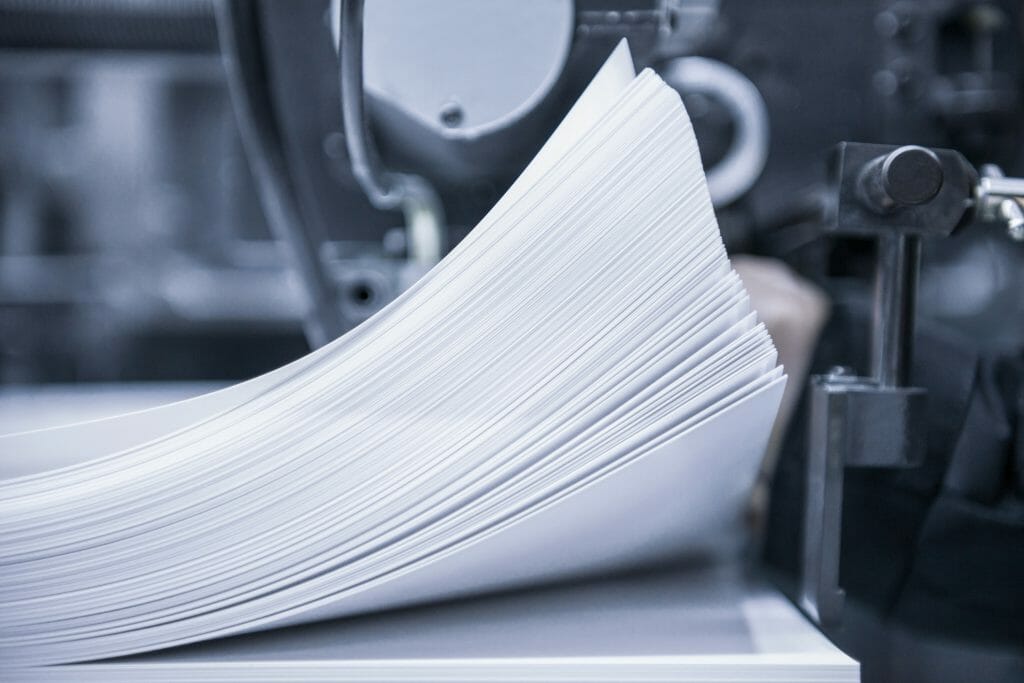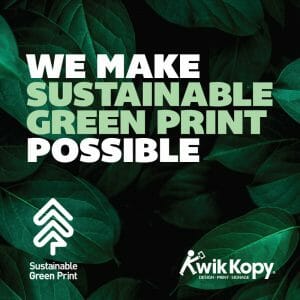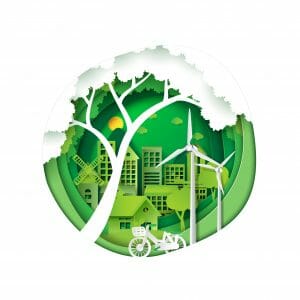Protecting the planet through sustainable printing: an industry-wide goal
Kwik Kopy is proud to be a pioneer of sustainable printing in an industry that is helping protect the future of our planet on a global scale.
Yes, you read that right. Paper production is largely thought to be the leading driver of deforestation, and yet paper – being biodegradable, compostable and recyclable – is actually one of the world’s greenest materials.
Plus, Aussies are fantastic recyclers, with over 87% of all our paper and paperboard being recovered.
Almost 90% of global deforestation is actually due to the agricultural industry. Meanwhile, the Australian printing industry sources its paper from planted forest operations, 90% of which are certified to comply with international standards for sustainable forest management practices.
Not to mention, the Australian pulp and paper industry is driving its greenhouse gas emissions down.
Our sustainability story at Kwik Kopy is nothing new: eco-friendly printing practices have long been central to our operations.
However, sustainability is becoming even more important for communities, organisations and individuals worldwide. We share your desire for a sustainable future, which is why we continually develop and introduce programs to curb environmental impact.
Read on as Peter Clarke, Owner and Director of Kwik Kopy Gosford, and Nick Tuit, Owner and Director of Kwik Kopy Circular Quay and Kwik Kopy Frenchs Forest, share their thoughts on the industry trend that is green print.
What do sustainable business practices look like in print?
Beyond using tightly controlled plantation harvesting to make paper, the printing industry is reducing its environmental impact in numerous ways. At Kwik Kopy, we do this not only in our business operations but also through our printing and copying services.
“We’re very conscious of ensuring that the product we offer is either sustainably grown or already in the circular economy that is print,” Nick says.
As a Kwik Kopy customer, you’ll almost always have the option to use recycled paper (which, by the way, can be recycled about eight times before its fibres start to lose the ability to bind together). Otherwise, all our virgin paper is sourced from suppliers that are certified by the Forest Stewardship Council (the body responsible for ensuring the sustainable management of planted forests).
The following green print practices are also used at our centres:
- Recycling wastepaper and offcuts (a decades-long Kwik Kopy practice)
- Opting for vegetable- or soy-based inks instead of solvent inks
- Using toner that separates from the paper easily
- Limiting the use of solvents used to wash down presses, and ensuring they aren’t tipped down the drain (we have a strict group-wide process for this)
- Upgrading printers to more energy-efficient models every four years (this alone has drastically reduced our power consumption over the last ten years)
- Ensuring printers’ power-saving options are enabled (this maximises opportunities to save power – especially during downtime)

Paper-based communications are typically gentler on the environment than digital.
The truth about paper
Common misconceptions about the print industry have given paper a bad rap. Allow us to alleviate your ‘paper guilt’ by busting some key myths you’ve no doubt heard.
Myth: Paper has a high carbon footprint
The persistent rumour that paper is bad for the environment has put pressure on people to switch from paper to digital. If you’ve ever been asked to ‘think before you print’ at work or been pushed by your bank to help ‘save a tree’ by receiving statements via email, you’ll know what we’re talking about. (Be aware: any company urging you to switch to digital correspondence is probably more interested in saving money than saving the planet!)
And yet, the reality is that paper-based communications are typically gentler on the environment than digital.
“Paper is carbon – carbon that’s been sucked out of the air by the tree it came from,” Nick points out. “If you’re reading a newspaper, you can guarantee that the growth of those trees has absorbed carbon from the atmosphere, whereas reading news online pumps carbon into the air through, normally, the burning of fossil fuels and also the manufacture of your device and how it’s disposed of.
“Most of your computer is not recyclable.”
So essentially, if you want to reduce your carbon footprint, you’re better off leafing through the newspaper than opening your laptop.
Myth: People prefer digital communication
Rapid technological advancement has improved our lives in many ways, but will digital communications replace paper altogether?
If the idea of doing away with physical books makes you shudder, you’re not alone. A 2016 study found that 74% of Australians prefer reading on paper to reading on a screen – with 71% of respondents appreciating the tactile experience it provides.
And this isn’t the only reason people still favour paper communications.
“Hard-copy reading helps with the retention of information,” Peter says. “A written training manual, book or story provides an image in your mind that your brain can retain so much better. And it’s so much easier to go back and refer to.”
With 86% of Australians wanting flexibility in how they receive correspondence from banks and service providers, we’d say paper is here to stay.

74% of Australians prefer reading on paper to reading on a screen
Our green print certification journey
Although Kwik Kopy has long been practising eco-friendly printing, we know our customers want to see evidence of our compliance with industry standards. So in 2019, we began obtaining Sustainable Green Print (SGP) certification for our centres.
SGP is an environmental certification program run by the Print & Visual Communication Association. Now that our sustainable printing processes are fully documented, 80% of our centres are certified under the program.
“We actually haven’t had to change much of our practices to be sustainably compliant because most of what we do is already sustainable,” Peter says. “Though it does provide a helpful sustainability framework to work towards. And having a certification to back you makes a big difference from a customer’s point of view.
“As a level-two SGP certified centre, Kwik Kopy Gosford has a monthly meeting where we go through our practices in terms of what our environmental concerns are and how we can improve on them.”
Our sustainability initiatives
To reduce our impact on the environment, we:
- Recycle our ink cartridges (refill and reuse)
- Re-engineer all printer parts and consumables
- Use LED lighting for our outward-facing lightboxes (we’re also introducing LEDs in our production areas)
- Power down our workstations and screens at the end of the day
- Buy power from renewable sources wherever possible (e.g. Aussie-owned energy company Red Energy)
- Make deliveries on e-bike (at Kwik Kopy Darling Harbour)
- Favour the use of Australian papers to reduce the carbon-intensive effects of international freight
- Use hemp or cotton bags and paper or cardboard packaging instead of plastic bags
- Discourage the use of laminates and plastic covers
- Offer reusable woven bags at point of sale
- Use biodegradable bubble wrap and packaging tape
- Treat any plastic packaging with a chemical that helps it break down (this process takes about 24 months)
- Encourage our people to commute via walking, cycling or public transport
- Have solar panels on the roof of some centres
- Install modern automated electrical wiring systems in our buildings (e.g. C-Bus by Clipsal)
We also give supplier boxes another life by reusing them for customer deliveries. You’ll see a paper-based ‘reduce, reuse, recycle’ sticker on these. (If your delivery box looks a little tattered, you know it’s not its first rodeo!)
Nick describes sustainable printing as an ongoing process of testing, measuring and adjusting.
“For example, we keep track of how much waste paper we’re disposing of, and we’re trying to improve that all the time,” he says.
Next up: improving our wide-format printing practices
Our current focus on Kwik Kopy is to adopt sustainable solutions for wide-format signage. While we already offer reusable and reskinnable pull-up banners, as well as fibre-based substrates rather than polypropylene, our next goal is to offer PVC-free vinyl.
“Particularly with signage, self-adhesive vinyl, pull-up vinyl banners and the plasticised canvases you might see hanging off a footbridge or a school fence – there are a lot of plastics, PVCs and polypropylene associated with those, and they just don’t break down very well,” Nick says. “Nor are they recyclable. So we’re looking at how we can improve that.”

We make eco-friendly printing possible
We make eco-friendly printing possible
Kwik Kopy’s commitment to sustainability is a key part of our new brand purpose, We Make Possible.
“We are constantly thinking about sustainability, sharing our wins and talking about the benefits of it,” Nick says.
“Our mission is to be up-front with our customers about everything we do and why paper is such a great product to continue using.”
We are proud to be able to offer sustainable print options to businesses and individual customers in all our services. Our expert team members can help you make eco-friendly printing choices that meet your quality and design standards while staying within budget.
Discover Kwik Kopy printing services near me to start your green printing journey today.






